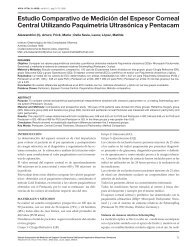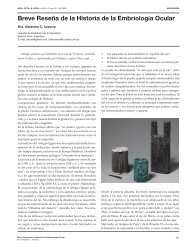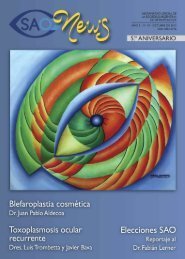Volumen 79 Número 1 - Sociedad Argentina de Oftalmología
Volumen 79 Número 1 - Sociedad Argentina de Oftalmología
Volumen 79 Número 1 - Sociedad Argentina de Oftalmología
Create successful ePaper yourself
Turn your PDF publications into a flip-book with our unique Google optimized e-Paper software.
ABSTRACT<br />
Objective: Obstetric complications, perinatal asphyxia (PA) inclu<strong>de</strong>d, are cause of retinal injuries as<br />
retinopathy of prematurity (ROP), a type of ischemic proliferative retinopathy. Up to date there are not<br />
experimental mo<strong>de</strong>ls for studying this disease.<br />
Methods: We present a mo<strong>de</strong>l of experimental PA which shows structural and ultrastructural retinal alterations.<br />
Results: We observed the pathologic <strong>de</strong>velopment of neovascular epirretinal membrane, neuro<strong>de</strong>generation,<br />
vessels of neoformation and astroglial reaction. These alterations are compatible with the histopathological<br />
<strong>de</strong>scription of ROP.<br />
Conclusions: This mo<strong>de</strong>l of PA is useful for studying the ROP at experimental level. The application of<br />
hypothermia has a potent protective effect in the <strong>de</strong>scribed alterations. This study could contribute in the<br />
<strong>de</strong>velopment of therapies in or<strong>de</strong>r to ameliorate or avoid the retinal damage. In this manner, hypothermia<br />
could improve life quality and <strong>de</strong>crease medical, familiar and social costs for evitable causes of blindness.<br />
Key words: retina, perinatal asphyxia, retinopathy of prematurity, hypothermia.<br />
Introducción<br />
La asfixia perinatal (AP) es el problema más serio<br />
a nivel mundial en Perinatología. Cada año, cuatro<br />
millones <strong>de</strong> recién nacidos sufren AP. Según<br />
numerosas estadísticas clínicas, una tercera parte<br />
fallece y otro tercio no pa<strong>de</strong>cerá consecuencias,<br />
mientras que el tercio restante sufrirá daños neurológicos,<br />
entre los cuales se incluyen diferentes<br />
grados <strong>de</strong> retinopatía isquémica (Hill 1 1991,<br />
Younkin 2 1992). La gravedad sufrida durante el<br />
parto no se relaciona con un pronóstico <strong>de</strong> morbo-mortalidad,<br />
y es así como casos <strong>de</strong> AP graves<br />
pue<strong>de</strong>n no <strong>de</strong>sarrollar lesiones neurológicas y<br />
casos leves pue<strong>de</strong>n terminar en espasticidad o<br />
muerte. Todo parece indicar que la susceptibilidad<br />
individual es el factor más importante en<br />
cuanto al <strong>de</strong>sarrollo <strong>de</strong> lesión en el sistema nervioso<br />
central (SNC). En países sub<strong>de</strong>sarrollados,<br />
la AP es un problema aún más grave, <strong>de</strong>bido a<br />
que las precauciones, o los cuidados necesarios,<br />
no son consi<strong>de</strong>rados o aplicados en forma a<strong>de</strong>cuada<br />
(Costello 3 , 1994).<br />
El crecimiento normal y la homeostasis <strong>de</strong><br />
un feto <strong>de</strong>pen<strong>de</strong>n <strong>de</strong> su a<strong>de</strong>cuado intercambio<br />
<strong>de</strong> gases, nutrientes y productos metabólicos<br />
con la placenta. Si estos mecanismos fallan, se<br />
establece una insuficiencia en los requerimien-<br />
Hacia un mo<strong>de</strong>lo experimental <strong>de</strong> ROP: estudio estructural y ultraestructural<br />
tos fetales, especialmente <strong>de</strong>l oxígeno, llevando<br />
a un estado <strong>de</strong> asfixia aguda o crónica. En el<br />
90% <strong>de</strong> los casos esta asfixia se produce durante<br />
el período ante-parto (compresión <strong>de</strong> cordón<br />
umbilical, malas maniobras obstétricas, placenta<br />
previa, <strong>de</strong>sprendimiento <strong>de</strong> placenta, envejecimiento<br />
placentario, hemorragia y/o anemia<br />
materna, toxemia gravídica, infarto placentario,<br />
etc.), <strong>de</strong>nominándose a este estado como asfixia<br />
perinatal (AP).<br />
La AP se encuentra entre aquellas afecciones<br />
que inducen una hipoxia-isquemia global en el<br />
SNC. El grado <strong>de</strong> severidad y el tiempo en que<br />
se mantiene el arresto <strong>de</strong> oxígeno serán <strong>de</strong>terminantes<br />
en el <strong>de</strong>sarrollo <strong>de</strong> las consecuencias <strong>de</strong><br />
esta afección. La mayoría <strong>de</strong> los infantes mueren<br />
en el período perinatal y el 20-30% <strong>de</strong> los sobrevivientes<br />
presentarán secuelas que se harán<br />
evi<strong>de</strong>ntes a corto o largo plazo entre las que se<br />
<strong>de</strong>stacan: el Síndrome <strong>de</strong> Déficit <strong>de</strong> Atención e<br />
Hiperactividad (DSM-III, American Psychiatric<br />
Association 4 , 1987), epilepsias, retardo mental,<br />
la parálisis cerebral o espasticidad; y alteraciones<br />
auditivas y visuales (Younkin, 1992).<br />
Entre los mecanismos involucrados en el<br />
daño neuronal por hipoxia-isquemia los más<br />
[ 21 ]






